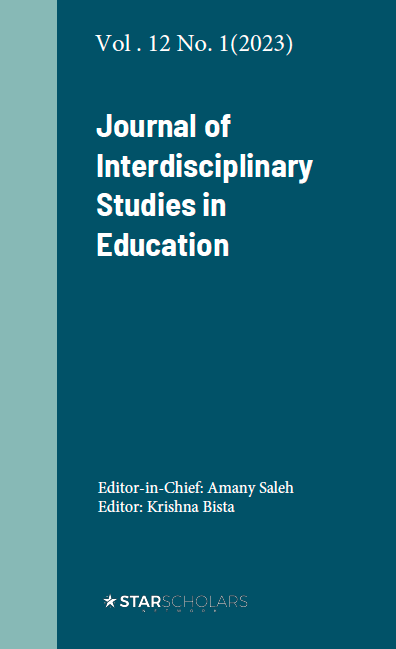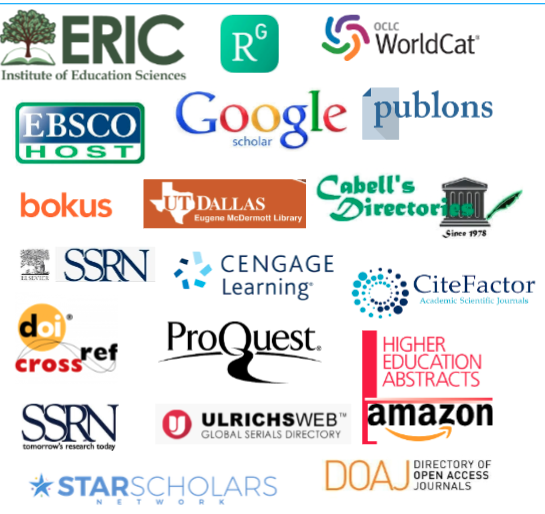The Creativity Lab: Interdisciplinary Creativity in Higher Education
Keywords:
Creative interdisciplinary collaboration,, creativity education, , experiential learning,, innovationAbstract
This qualitative study explores how educators can foster creativity across disciplines through a conceptual framework for creative interdisciplinary collaboration. The article introduces the Creativity Lab process model, which generates collaboratively developed, multifaceted but cohesive project ideas. The author argues that while creativity and collaboration are recognized as important 21st-century skills, opportunities for learning the granular mechanics of creative interdisciplinary collaboration are not yet fully integrated into higher education. The process model addresses this and offers a practical way to foster creative confidence in participants, encourage pluralities and possibilities through gamification, and emphasize integration and cohesion of multiple perspectives in ideas. The article concludes that educational institutions have an opportunity to build the capacity of students and faculty to become skilled at creative collaborations across disciplines, and the Creativity Lab process model offers a specific approach to doing this.
Downloads
References
Botella, M., Zenasni, F., & Lubart, T. (2018). What are the stages of the creative process? What visual arts students are saying. Frontiers in Psychology, 9. https://doi.org/10.3389/fpsyg.2018.02266
Brett, N. (2018, December 20). Future graduates will need creativity and empathy, not just technical skills. The Guardian. http://www.theguardian.com/education/2018/dec/20/future-graduates-will-need-creativity-and-empathy-not-just-technical-skills
Bruno, C., & Canina, M. (2019). Creativity 4.0. Empowering creative process for digitally enhanced people. The Design Journal, 22:sup1, 2119-2131. https://doi.org/10.1080/14606925.2019.1594935
Buchanan, R. (1992). Wicked problems in design thinking. Design Issues, 8(2), 5. http://web.mit.edu/jrankin/www/engin_as_lib_art/Design_thinking.pdf
Cook, V., Major, L., Warwick, P., & Vrikki, M. (2020). Developing collaborative creativity through microblogging: A material-dialogic approach. Thinking Skills and Creativity, 37, 100685. https://doi.org/10.1016/j.tsc.2020.100685
Craft, A. (2014). Possibility Thinking: From what is to what might be. In S. Robson, & S. Flannery Quinn (Eds.), The Routledge international handbook of young children’s thinking and understanding. London: Routledge
Cross, N. (1982). Designerly ways of knowing. Design Studies, 3(4), 221–227. http://www.makinggood.ac.nz/media/1255/cross_1982_designerlywaysofknowing.pdf
Cross, N. (2001). Designerly ways of knowing: design discipline versus design science. Design Issues, 17(3), 49–55. http://oro.open.ac.uk/3281/1/Designerly-_DisciplinevScience.pdf
Daly, S. R., Mosyjowski, E. A., Oprea, S. L., Huang-Saad, A., & Seifert, C. M. (2016). College students’ views of creative process instruction across disciplines. Thinking Skills and Creativity, 22, 1–13. https://doi.org/10.1016/j.tsc.2016.07.002
Friis Damm, R., & Siang, T. Y. (2020). Design thinking: Get a quick overview of the history. The Interaction Design Foundation. https://www.interaction-design.org/literature/article/design-thinking-get-a-quick-overview-of-the-history
Guyotte, K. W., Sochacka, N. W., Costantino, T. E., Kellam, N. N., & Walther, J. (2015). Collaborative creativity in steam: Narratives of art education students’ experiences in transdisciplinary spaces. International Journal of Education and the Arts, 16(15), 1-38.
Hasso Plattner Design Thinking Research Program (2010, November 8) An introduction to design thinking process guide. https://web.stanford.edu/~mshanks/MichaelShanks/files/509554.pdf
Hämäläinen, R., & Vähäsantanen, K. (2011). Theoretical and pedagogical perspectives on orchestrating creativity and collaborative learning. Educational Research Review, 6 (3), 169-184. doi:10.1016/j.edurev.2011.08.001
Jónsdóttir, S. R. (2017). Narratives of creativity: How Eight teachers on four school levels integrate creativity into teaching and learning. Thinking Skills and Creativity, 24, 127–139. https://doi.org/10.1016/j.tsc.2017.02.008
Karakaya, A. F., & Demirkan, H. (2015). Collaborative digital environments to enhance the creativity of designers. Computers in Human Behavior, 42, 176-186. DOI: https://doi.org/10.1016/j.chb.2014.03.029.
Lewrick, M., Link, P., & Leifer, L. (2018). The design thinking playbook. Wiley.
Livingstone, L. (2010). Teaching creativity in higher education. Arts Education Policy Review, 111, 59–62. https://doi.org/10.1080/10632910903455884
Michalko, M. (2006). Thinkertoys. Ten Speed Press.
Mitchel-Marquis, K. (2021). Research Notes.
Parameswaran, U. D., Ozawa-Kirk, J. L., & Latendresse, G. (2019). To live (code) or to not: A new method for coding in qualitative research. Qualitative Social Work, 19(4), 630–644. https://doi.org/10.1177/1473325019840394
Peter, R. (1987). Design Thinking. https://mitpress.mit.edu/books/design-thinking
Powers, A. (2018, April). Creativity is the skill of the future. Forbes. www.forbes.com/sites/annapowers/2018/04/30/creativity-is-the-skill-of-the-future/#2b69a0854fd4
Pennington, D. R. (2016). Coding of non-text data. The SAGE Handbook of Social Media Research Methods, 232–250. https://doi.org/10.4135/9781473983847.n15
Reiter-Palmon, R., & Leone, S. (2018) Facilitating creativity in interdisciplinary design teams using cognitive process.” Proceedings of the Institution of Mechanical Engineers, Part C: Journal of Mechanical Engineering Science, 233(2), 385–394. DOI.org/10.1177/0954406217753236
Saldaña, J. (2011) Fundamentals of qualitative research. Oxford University Press
Saldaña, J. (2016) The coding manual for qualitative researchers, (3rd ed.) SAGE
Schmoelz, A. (2018). Enabling co-creativity through digital storytelling in education. Thinking Skills and Creativity, Vol. 28, pp 1-13. DOI:https://doi.org/10.1016/j.tsc.2018.02.002.
Serrat O. (2017) The SCAMPER technique. Knowledge Solutions. Springer, Singapore. https://doi.org/10.1007/978-981-10-0983-9_33
Swirski, T. (2012). Towards the Digital Creativity of Action. in K.C. Lee (ed.) Digital Creativity: Individuals, Groups, and Organizations. Springer.
The Business-Higher Education Forum. (2018). The new foundational skills of the digital economy: Developing the professionals of the future
Walsh, C., Chappell, K., & Craft, A. (2017). A co-creativity theoretical framework to foster and evaluate the presence of wise humanising creativity in virtual learning environments (VLEs). Thinking Skills and Creativity, 24, 228-241. https://doi.org/10.1016/j.tsc.2017.01.001.
World Economic Forum. (2017). Accelerating workforce reskilling for the fourth industrial revolution. www.weforum.org/whitepapers/accelerating-workforce-reskilling-for-the-fourth-industrial-revolution
Jezard, A. (2018). The 3 skill sets workers need to develop between now and 2030. World Economic Forum www.weforum.org/agenda/2018/06/the-3-skill-sets-workers-need-to-develop-between-now-and-2030/
Ziv, S. (2019). 10 traits that will make you a successful leader, according to Google's internal research. Business Insider www.businessinsider.com/10-traits-that-will-make-you-a-successful-leader-in-google-2018-3?r=US&IR=T
Additional Files
Published
Issue
Section
License
Copyright (c) 2023 Anna Griffith

This work is licensed under a Creative Commons Attribution-NonCommercial-NoDerivatives 4.0 International License.







